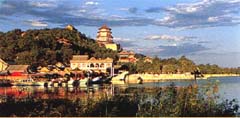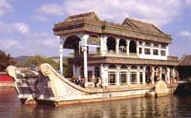Online Courses
Study in China
About Beijing
The Summer Palace
 The Summer Palace (Yi He Yuan) lies about 20 kilometers northwest of Beijing. It consists of Longevity Hill (59 meters high) and Kunming Lake with a total area of 290 hectares. Longevity Hill is an extension of the Western Hills. Kunming Lake used to be fed by the springs from the Jade Spring Hill lying to its west. Now it has its source from Miyun Reservoir, 102 kilometers northeast of Beijing.
The Summer Palace (Yi He Yuan) lies about 20 kilometers northwest of Beijing. It consists of Longevity Hill (59 meters high) and Kunming Lake with a total area of 290 hectares. Longevity Hill is an extension of the Western Hills. Kunming Lake used to be fed by the springs from the Jade Spring Hill lying to its west. Now it has its source from Miyun Reservoir, 102 kilometers northeast of Beijing.
The Summer Palace has a history of over 800 years. In 1153 when the Jin Dynasty made Beijing (then called Yanjing) its capital, it built an imperial palace (the Golden Hill Palace) on the present site of the Summer Palace. In l750, Emperor Qianlong spent 4.8 million taels of silver building the Garden of Clear Ripples and changes the name the hill to Longevity Hill to celebrate his mother's birthday. He also named the lake Kunming because he wanted to follow the sample of Emperor Wudi of the Han Dynasty who had trained his navy centuries before in Kunming Pool in Chang'an (somewhere near Xi'an today).
 The Summer Palace is the best-kept existing royal garden in Beijing. With a concentration of the best of ancient buildings as well as garden styles, it is a virtual museum of traditional Chinese gardens. The main building in the Summer Palace is Fo Xiang Ge, or Pavilion of Incense Fragrance, atop Longevity Hill. The pavilion, 40 meters high, has eight facades, three stories and four tiers of roof. It represents the best of ancient Chinese architecture. One of the most interesting features of the garden is the Long Corridor, a covered veranda of 728 meters long with painted beams bearing more than 4,000 pictures of landscapes as well as famous historical and fictional events. The Summer Palace concentrates the best of Chinese garden styles. In the east, halls and houses form enclosed compounds linked to one another by corridors, a style derived from the courtyard houses of North China. In the south, an embankment lined with willows cuts through the lake, an imitation of the scenic West Lake in Hangzhou. On the north slope of Longevity Hill are structures resembling Tibetan lamaseries. In the north is a shop-lines street named after Suzhou, a commercial city near shanghai. The marble boat on the edge of the lake has an ironic significance.
The Summer Palace is the best-kept existing royal garden in Beijing. With a concentration of the best of ancient buildings as well as garden styles, it is a virtual museum of traditional Chinese gardens. The main building in the Summer Palace is Fo Xiang Ge, or Pavilion of Incense Fragrance, atop Longevity Hill. The pavilion, 40 meters high, has eight facades, three stories and four tiers of roof. It represents the best of ancient Chinese architecture. One of the most interesting features of the garden is the Long Corridor, a covered veranda of 728 meters long with painted beams bearing more than 4,000 pictures of landscapes as well as famous historical and fictional events. The Summer Palace concentrates the best of Chinese garden styles. In the east, halls and houses form enclosed compounds linked to one another by corridors, a style derived from the courtyard houses of North China. In the south, an embankment lined with willows cuts through the lake, an imitation of the scenic West Lake in Hangzhou. On the north slope of Longevity Hill are structures resembling Tibetan lamaseries. In the north is a shop-lines street named after Suzhou, a commercial city near shanghai. The marble boat on the edge of the lake has an ironic significance.
In 1860, the Anglo-French allied forces invaded Beijing and turned down the palace. In 1888, Empress Dowager Cixi had it restored with the funds (30 million taels of silver) intended for the development of the navy and renamed it the Summer Palace. In 1900, it was again plundered, this time by the invading troops of the eight powers. The big temples and halls at the back of the Longevity Hill were destroyed. Only one temple remained, the Hall of Sea of Wisdom, a stone structure. In 1903 the Empress Dowager spent a fabulous sum of money to have the palace reconstructed a second time.
The Summer Palace of today is more or less the same as the palace rebuilt in 1903. After the last Qing Emperor Puyi was thrown out of the Summer Palace in 1924,this place was turned into a park. But the admission charge was very high, about the price of a bag of wheat flour, equivalent to 8 yuan now, Today, a ticket costs only one yuan. Since liberation the Chinese Government has renovated the Summer Palace several times and numerous trees and flowers have been planted. This old imperial garden has taken on a completely new look and become one of the most popular parks in Beijing.
